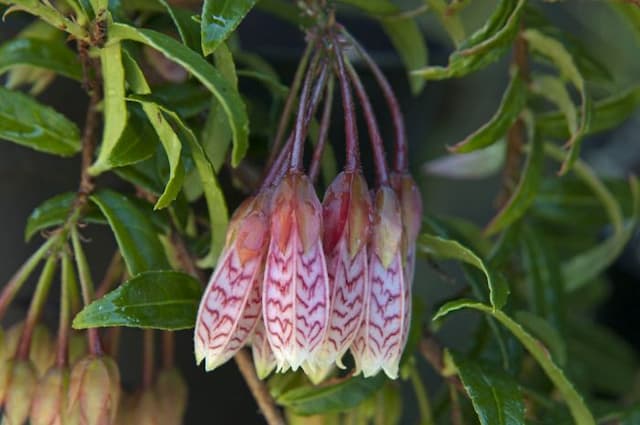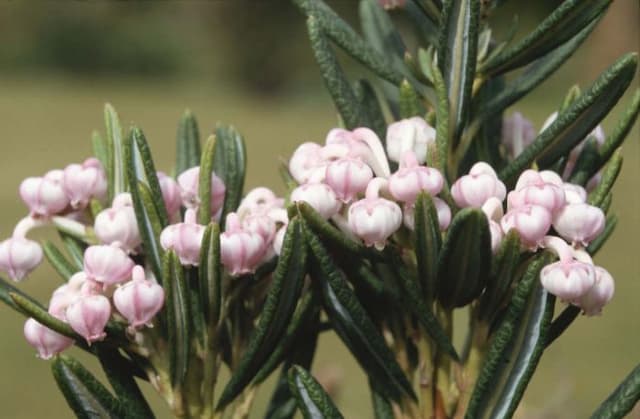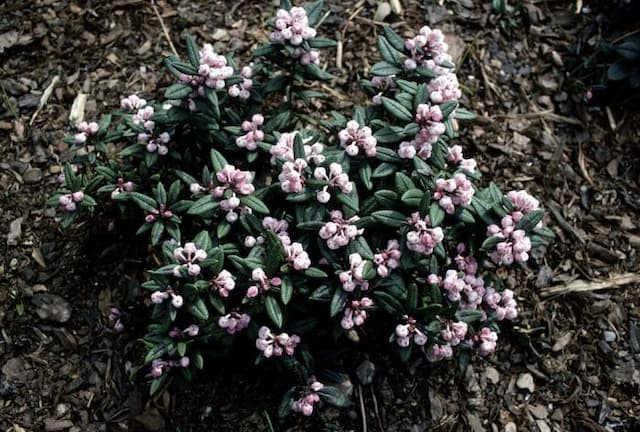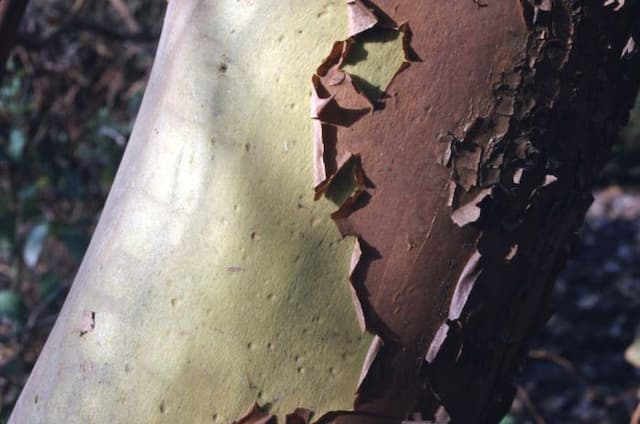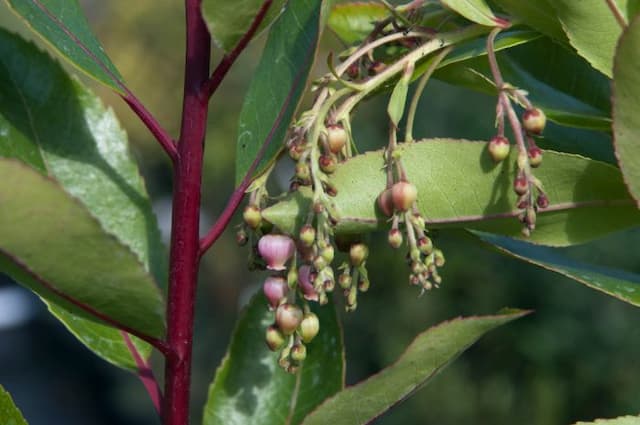Azalea Rhododendron 'Marietta'

ABOUT
Rhododendron 'Marietta' is an ornamental bush known for its striking flowers and lush foliage. The plant boasts splendid blooms that typically present a vibrant color mix, often described as rich purples with hints of white to pink, although the exact shade can vary. The flowers are funnel-shaped and usually gather in large clusters, known as trusses, which create a dazzling display that is visually captivating. The leaves of this rhododendron are equally impressive, characterized by a deep green color and a glossy, leathery texture. The foliage forms a dense backdrop for the flowers, adding to the plant's overall lush appearance. The leaves may also have a slight curl to their edges, which further accentuates their thickness and health. This rhododendron is a beloved choice for gardens due to its ornamental qualities and the visual impact of its blooms.
About this plant
 Names
NamesFamily
Ericaceae
Synonyms
Marietta Azalea
Common names
Rhododendron 'Marietta'
 Toxicity
ToxicityTo humans
Rhododendron is toxic to humans if any part of the plant is ingested. The plant contains a group of toxic compounds known as grayanotoxins. Symptoms of rhododendron poisoning can include vomiting, diarrhea, hypersalivation, weakness, coma, hypotension, central nervous system depression, cardiovascular collapse, and potentially death. The severity of the poisoning can vary based on the amount ingested and the individual's sensitivity to the toxins.
To pets
Rhododendron is also toxic to pets, including dogs and cats, if any part of the plant is ingested. The toxins present in rhododendron, called grayanotoxins, can cause symptoms such as vomiting, diarrhea, drooling, weakness, loss of appetite, abdominal pain, abnormal heart rate and rhythm, collapse, and in severe cases, coma or death. The seriousness of the symptoms depends on the amount ingested and the size and health of the pet.
 Characteristics
CharacteristicsLife cycle
Perennials
Foliage type
Evergreen
Color of leaves
Green
Flower color
Pink
Height
4-5 feet (1.2-1.5 meters)
Spread
4-6 feet (1.2-1.8 meters)
Plant type
Shrub
Hardiness zones
5-9
Native area
Asia
Benefits
 General Benefits
General Benefits- Aesthetic Appeal: Rhododendron 'Marietta' adds vibrant color and beauty to gardens with its striking purple flowers.
- Attracts Pollinators: The blooms provide nectar for bees, butterflies, and other beneficial insects.
- Shade Tolerance: This particular variety can thrive in partially shaded areas where other plants might struggle.
- Ease of Care: Rhododendron 'Marietta' is known for being relatively low maintenance compared to other shrubs.
- Long Blooming Season: It has a long flowering period that extends the visual interest in the garden through multiple seasons.
- Versatility: The plant can be used in landscape design as a border, standalone specimen, or in mass plantings.
- Hardiness: It is capable of withstanding cooler temperatures, making it suitable for a variety of climates.
- Erosion Control: Rhododendron 'Marietta' can help in stabilizing slopes and preventing soil erosion due to its root system.
- Habitat Creation: The shrub can provide shelter and nesting sites for birds and other small wildlife.
- Year-Round Interest: Even when not in bloom, the evergreen foliage offers color and structure throughout the year.
 Medical Properties
Medical PropertiesThis plant is not used for medical purposes.
 Air-purifying Qualities
Air-purifying QualitiesThis plant is not specifically known for air purifying qualities.
 Other Uses
Other Uses- Rhododendron 'Marietta' can be used as a natural dye source. The flowers and leaves can produce dyes for textiles and crafts.
- The plant's large, showy blossoms are suitable for pressing and can be used in creating botanical artwork or crafts.
- Sometimes it is incorporated into landscape design as a living privacy screen due to its dense foliage.
- In colder climates, Rhododendron 'Marietta' might be used as a winter garden focal point because of its evergreen nature.
- Rhododendron leaves can be used in floral arrangements as a long-lasting green backdrop for other flowers.
- The thick foliage is sometimes used as a protective cover for beneficial insects and small wildlife during inclement weather.
- Rhododendrons can be used for bonsai, providing a challenge due to their larger leaves but creating striking miniature trees.
- Since these plants are acid-loving, fallen Rhododendron leaves may help acidify the soil in compost piles or when used as a mulch.
- Some artists use the intricate patterns of the Rhododendron bark in their artwork, either as a natural texture in multimedia pieces or as inspiration.
- In educational settings, the plant can be used to study soil acidity preferences and the impact of soil composition on plant health.
Interesting Facts
 Feng Shui
Feng ShuiThe Rhododendron is not used in Feng Shui practice.
 Zodiac Sign Compitability
Zodiac Sign CompitabilityThe Rhododendron is not used in astrology practice.
 Plant Symbolism
Plant Symbolism- Warning: Rhododendrons are often symbolic of caution, due to their poisonous nature, reminding individuals to beware of apparent beauty that may hide potential danger.
- Temperance: Their toxic qualities also lead to an association with temperance, as they require careful handling, symbolizing the importance of moderation in all things.
- Elegance: The showy flowers of the rhododendron signify elegance and wealth, with their lush blooms often found in upscale gardens and estates.
- Benevolence: In some cultures, the rhododendron is a symbol of benevolence and charity, perhaps because of its generous display of flowers.
- Passion: The intense, vivid colors of the rhododendron flowers can represent passion and the flowering of love in one's life.
- Survival: As rhododendrons can thrive in rocky, challenging environments, they symbolize hardiness and the ability to overcome adversity.
 Water
WaterAzaleas require even moisture and do not fare well in overly wet or dry conditions. Keep the soil consistently moist by watering the azalea about once a week, giving it approximately 1 gallon of water each time for medium-sized shrubs. During hot or dry weather, the frequency may need to increase to twice a week. Be sure to water deeply at the base of the plant rather than sprinkling water over the foliage to avoid fungal diseases. In winter, reduce watering but do not let the soil become completely dry.
 Light
LightAzaleas thrive in dappled sunlight or partial shade. An ideal spot is where they can receive filtered sunlight through tree branches or morning sun followed by afternoon shade. Avoid exposure to intense afternoon sun which can scorch the leaves and stress the plant.
 Temperature
TemperatureAzaleas prefer a temperate climate with temperatures ranging between 50°F and 80°F. They can survive minimum temperatures as low as 20°F, though hardiness can vary among varieties. It's important to protect azaleas from freezing temperatures and harsh winter winds which can damage the plant.
 Pruning
PruningPrune azaleas for shape and to remove dead or diseased wood. The best time for pruning is immediately after the spring blooming period, as azaleas set next year's flower buds by midsummer. Typically, pruning once a year is enough. When pruning, make clean cuts at a slight angle just above a set of leaves.
 Cleaning
CleaningAs needed
 Soil
SoilAzaleas enjoy a well-draining, acidic soil mix with a pH of 4.5 to 6.0. A mixture of 50% peat moss or a specialized rhododendron/azalea mix with 50% pine bark or perlite works well.
 Repotting
RepottingAzaleas should be repotted every 2-3 years or when the plant outgrows its current pot; spring is the ideal time for repotting.
 Humidity & Misting
Humidity & MistingAzaleas thrive at a moderate humidity level, between 40-60%; they benefit from occasional misting if indoor humidity is low.
 Suitable locations
Suitable locationsIndoor
Place azalea in bright, indirect light and away from dry heat sources.
Outdoor
Plant azalea in partial shade with shelter from afternoon sun.
Hardiness zone
5-8 USDA
 Life cycle
Life cycleThe Rhododendron 'Marietta', commonly known as Rhododendron, starts its life cycle as a seed, which upon germination in the right conditions of moisture and temperature, develops into a seedling. It then grows into a juvenile plant where leaf and root development are prioritized to establish the plant. As it matures, it enters the vegetative stage where it continues to grow in size and foliage density. Following the vegetative stage, it reaches the reproductive stage, characterized by the blooming of vibrant flowers typically in spring which attract pollinators for sexual reproduction. Once pollinated, the flowers develop into seed pods, dispersing seeds for the next generation. As it ages, growth slows and it eventually reaches the senescence stage, where older rhododendrons may show signs of decline in vigor before eventually dying.
 Propogation
PropogationPropogation time
Early Spring
Rhododendron 'Marietta', commonly known as azalea, is most effectively propagated by semi-hardwood cuttings. This method is typically done in the late summer after the blooms have faded and the new growth has started to mature and harden slightly. To propagate, take 4- to 6-inch cuttings from healthy, disease-free plants, ensuring each cutting has several sets of leaves. The bottom set of leaves should be removed, and the cut end dipped in rooting hormone to encourage root development. The prepared cutting is then inserted into a pot filled with a mixture of peat and perlite, ensuring good contact between the cutting and the rooting medium. The pot should be covered with plastic or placed in a propagator to maintain a humid environment and kept in bright, indirect light. Rooting typically occurs within several weeks to months, at which point the new azalea plant can be gradually acclimatized to less humid conditions before being planted out.
